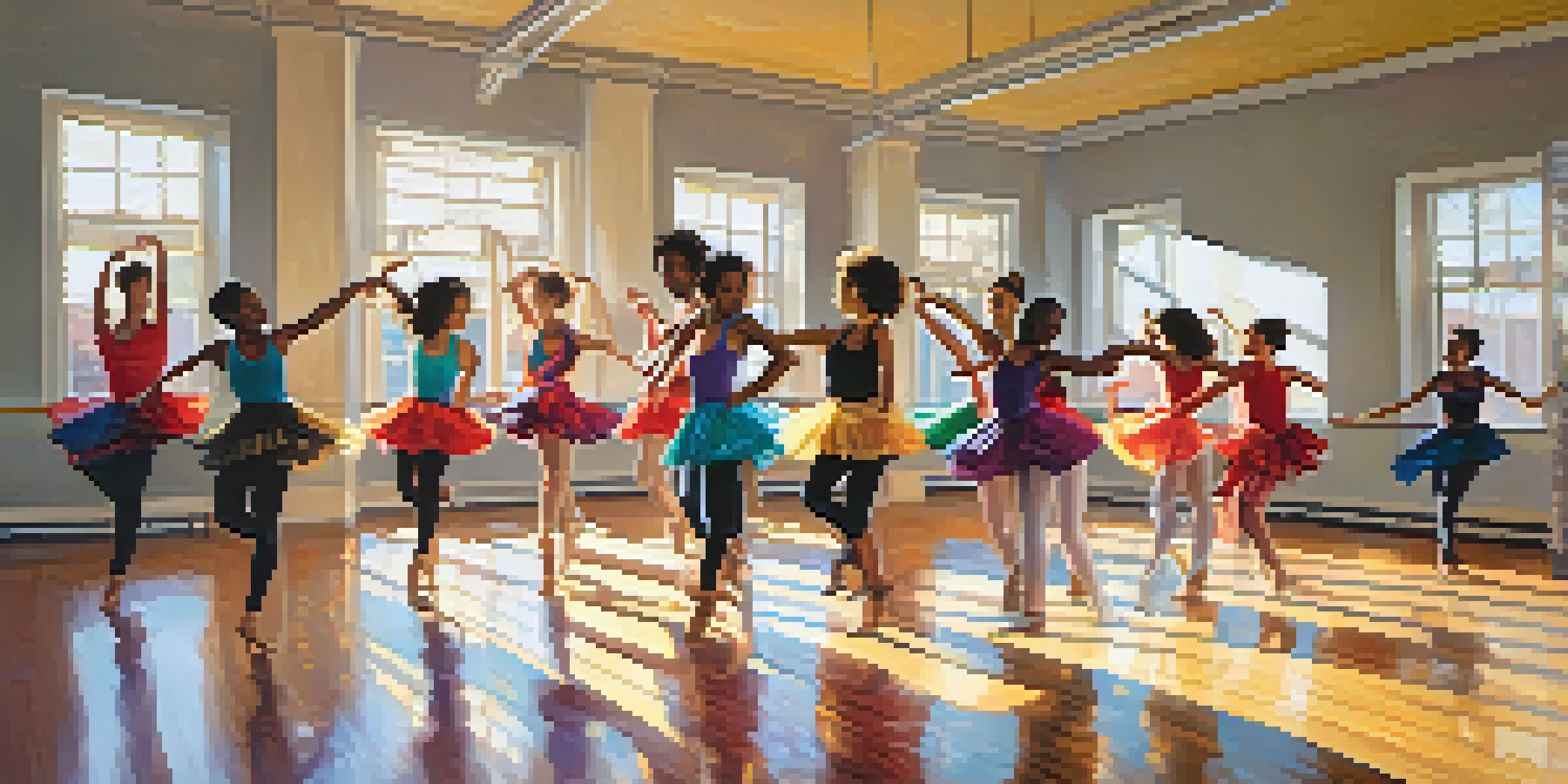The Impact of Music on Time in Dance and Movement

Understanding the Connection Between Music and Movement
Music and movement have been intertwined for centuries, creating a natural rhythm that guides dancers. The beat of a song often dictates the tempo of a dance, making it essential for performers to synchronize their movements with the music. This connection is not just physical; it taps into our emotions, often leading to a more expressive performance.
Dance is the hidden language of the soul.
When dancers hear music, they're not just hearing notes; they're feeling the tempo, melody, and dynamics that inform their movements. For instance, a fast-paced song might urge a dancer to perform quick, energetic steps, while a slow ballad invites more fluid, graceful motions. This interplay between music and movement showcases how deeply they influence each other.
Moreover, understanding this connection enriches the overall dance experience. Dancers can use music as a tool to evoke specific feelings, allowing them to tell a story through their movements. The harmony between sound and motion is what makes dance a powerful form of expression.
The Role of Rhythm in Dance Timing
Rhythm serves as the backbone of any dance performance, providing a structure that dancers can rely on. It's like the heartbeat of a song, giving dancers a steady pulse to follow. This rhythmic foundation helps create a sense of timing, ensuring that movements are executed in harmony with the music.

For example, in styles like hip-hop, the off-beat rhythms allow for unique interpretations, where dancers can emphasize specific beats with their movements. In contrast, ballet relies heavily on classical music, where the rhythm is more defined and structured, guiding dancers through intricate steps and formations. Each style showcases the versatility of rhythm in shaping dance.
Music Shapes Dance Expression
The interplay between music and movement allows dancers to evoke emotions and tell compelling stories through their performances.
Understanding rhythm enhances a dancer's ability to interpret music creatively. When dancers learn to connect with the underlying beat, they can explore new ways to express themselves, pushing the boundaries of their art. This deeper understanding of rhythm ultimately leads to more captivating performances.
How Tempo Influences Dance Styles
Tempo, or the speed of the music, plays a crucial role in determining the style and energy of a dance. Faster tempos often lend themselves to high-energy styles like salsa or swing, where quick footwork and lively movements dominate. Conversely, slower tempos are ideal for styles such as contemporary or lyrical dance, emphasizing fluidity and emotional expression.
Music can change the world because it can change people.
A dancer's ability to adapt to different tempos can significantly impact their versatility. For instance, a skilled dancer may seamlessly transition from a fast-paced hip-hop routine to a slow, expressive contemporary piece, showcasing their range and adaptability. This skill not only enhances their performance but also enriches their overall dance experience.
Moreover, tempo affects the audience's perception of a performance. A fast-paced dance can evoke excitement and exhilaration, while a slower piece may elicit introspection and emotion. Understanding how tempo influences dance allows performers to connect more deeply with their audience.
The Emotional Impact of Music on Dance
Music has a profound ability to evoke emotions, and this is particularly evident in dance. The right piece of music can inspire a dancer to channel feelings of joy, sadness, or even nostalgia through movement. This emotional connection often transforms a routine into a compelling story that resonates with viewers.
Take, for instance, a contemporary dance set to a haunting ballad. The dancer may use their body to express feelings of longing or heartbreak, creating a powerful connection with the audience. This emotional depth is what makes dance a unique and impactful art form, as it transcends words and communicates through movement.
Rhythm Guides Dance Timing
Rhythm serves as the backbone of dance, providing a structured pulse that dancers follow to synchronize their movements with music.
Ultimately, the emotional impact of music enriches the dance experience for both performers and audiences alike. When dancers tap into these feelings, they create performances that linger long after the music stops, forging a bond between artist and viewer.
Cultural Influences on Music and Dance Dynamics
Cultural background plays a significant role in shaping the relationship between music and dance. Different cultures have their unique styles, rhythms, and interpretations of movement, deeply influenced by their musical traditions. For instance, African dance often emphasizes polyrhythms, where multiple rhythms are layered over one another, creating complex and vibrant movements.
Similarly, Latin dance styles like tango and cha-cha reflect the passionate and intricate rhythms of their music. Dancers learn to embody the cultural nuances of their respective styles, allowing them to express their heritage through movement. This cultural context adds depth to the performance, making it more than just a dance; it becomes a storytelling medium.
Understanding these cultural influences enriches a dancer's repertoire. It fosters appreciation for the diverse forms of expression found around the world, encouraging dancers to explore and incorporate various elements into their own performances. This celebration of diversity in music and dance ultimately leads to a richer artistic landscape.
Music as a Tool for Enhancing Dance Practice
Integrating music into dance practice can significantly enhance a dancer's training experience. Music not only makes practice more enjoyable but also helps dancers internalize timing and rhythm. By practicing with music, dancers learn to synchronize their movements, making it easier to perform seamlessly during a routine.
For example, a dancer might practice a choreography section with the music playing at a slower tempo, allowing them to focus on executing movements accurately. As they become more confident, they can gradually increase the tempo, ensuring they’re prepared for the final performance. This method not only builds skill but also fosters a deeper connection to the music.
Cultural Influences Enrich Dance
Cultural backgrounds significantly shape the relationship between music and dance, adding depth and storytelling elements to performances.
Additionally, music can serve as a motivational tool, energizing dancers during rehearsals. Upbeat tracks can boost enthusiasm, while slower, soothing melodies can help dancers focus on technique and form. By consciously choosing music that aligns with their practice goals, dancers can create a more effective and enjoyable training environment.
The Future of Music and Dance Integration
As technology advances, the integration of music and dance continues to evolve. Innovations like virtual reality and augmented reality are providing dancers with new avenues for creative expression. These technologies allow for immersive experiences where dance and music can interact in ways previously unimaginable, opening up exciting possibilities.
Moreover, the rise of digital platforms has made it easier for dancers to explore diverse musical styles around the world. With just a few clicks, dancers can access a vast array of music, enriching their performances and broadening their artistic horizons. This democratization of music encourages exploration and experimentation within the dance community.

Looking ahead, the fusion of music and dance is likely to become even more dynamic. As artists from various backgrounds collaborate and experiment, we can expect to see innovative performances that challenge traditional boundaries. The future of this integration promises to be as vibrant and diverse as the art forms themselves.